
Martha Russo didn’t always dream of being an artist. As an accomplished field hockey player, Russo took a year off from Princeton University in 1984 to try out for the U.S. Olympic team. On the final day of tryouts, she suffered a career-ending knee injury.
“I was heartbroken,” Russo says. “They said I really shouldn’t play running sports anymore, which was really devastating.”
Russo spent the rest of the year studying in Italy, which sparked her interest in art. Upon returning to school, she enrolled in ceramics classes.
“Ceramics really just became my new sport,” she says.
Russo honed her craft with the tenacity of an Olympic athlete. She made up for her lack of knowledge and experience with sheer discipline.
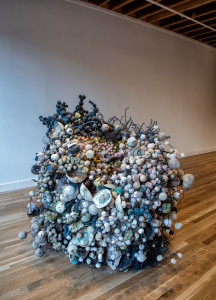
Twenty-five years later, Russo’s new ceramics exhibit, coalescere, follows her quarter-century career, telling the story of her artistic growth and personal journey. Now showing at Boulder Museum of Contemporary Art (BMoCA), coalescere explores Russo’s interest in the idea that two opposites are actually one in the same. The theme doesn’t just influence her sculptures — it pervades the exhibition, her creative process and her life.
The exhibition begins with “Phagocytosis”, a recent work that combines her past and present styles. The giant, cell-like ball of metal and clay invites the audience to explore it on all sides. Like much of her work, “Phagocytosis” lies somewhere between abstract and recognizable.
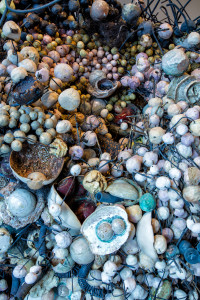
The piece was inspired in part by Russo’s experience at Princeton, where she studied biology and psychology. Bodily, psychological and scientific subject matter would later feature prominently in her work. The word “Phagocytosis”, which comes from the Greek “to devour,” also foreshadows Russo’s unexpected consumption by art.
Russo features many of her early works in the beginning of the exhibition. These works, specifically “Yon,” “Vagus” and “Drop,” combine references to the body with a nail-biting fragility. The result is a sense of the impermanence of ourselves and our bodies — a feeling which was no doubt inspired by her injury.
“Yon” takes the form of two stomachs connected by a long, esophagus-like tube. The 15-foot-long ceramic sculpture, which lies directly on the ground, could be stepped on and destroyed at any moment.
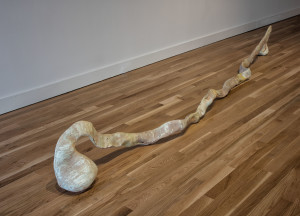
“I don’t know what’s going to happen,” Russo says. “It may fall apart during the show.”
These stomachs represent both that of the audience and of Russo herself. She says that she’d like the audience to feel her work first — to experience it on a gut level before conceptualizing it — another reason she likes to keep her forms ambiguous.
“I’m really going for visceral reactions. That’s the most important thing to me, that you feel it in your body,” Russo says. “It’s really like you’re absorbing through your skin, and there’s no controlling it. It’s just happening to you.”
More than that, the stomachs in “Yon” mirror Russo’s creative process. After enrolling in graduate school at the University of Colorado Boulder in the early ’90s, she found freedom in turning her mind off, trusting her gut and focusing on the process of creating, above all else.
“There was all this banter about post-modernism. I did not even know what modernism really was, and I felt queasy when asked about what I was making and why,” Russo says. “Really, all I knew was that I loved to retreat to my studio and make things.”
This relentless dedication to the physical side of her craft led to a realization that would shape her artistic style and the creation of her most well-known work.
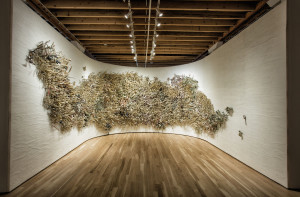
“Nomos” is the centerpiece of the exhibition and marks the turning point of Russo’s artistic development. In graduate school, Russo began to handcraft foot-long, tube-like sculptures from porcelain. She became a one-woman factory, churning them out religiously with no clear purpose.
“I had no idea what I was doing — I just liked making them,” Russo says. “It was the quickest thing I could make.”
Their production turned obsessive as Russo moved her studio into CU’s kiln shed to increase her output, and it became her Master of Fine Arts exhibition.
One night, while squid fishing with her siblings in Rhode Island, Russo looked into the water to find their boat completely surrounded in a sea of squid, and “Nomos” was born.
She realized she could reproduce the effect of the squids by sticking hundreds of the porcelain tubes into a peg board.
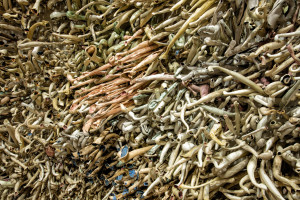
The pieces came to life. Despite being the result of strictly regimented labor, “Nomos” flowed. Even with the sheer number of individual pieces, it was natural and incredibly light.
This relationship between seemingly opposite concepts has always intrigued Russo. During her time at Princeton, she was exposed to the work of the Greek philosopher Heraclitus, who argued that opposites are really just a hair apart. Opposites aren’t binary, he said — they’re really two ends of a single spectrum.
For Russo, something clicked. She realized that work and creativity, or routine and spontaneity, were really not opposites. They’re the same. After doing enough painstaking work, the mind lets its guard down and stops filtering itself.
“That’s when the best stuff starts to happen,” Russo says. “It’s almost like you try to get yourself tired to the point where you’re really making something.”
Russo has continued making pieces for “Nomos” for the past 25 years. She’s used multiple tons of clay and has amassed thousands of pieces.
The current incarnation, at BMoCA, is the largest yet. Russo worked with a team of engineers to create the wall that holds the pieces. They make up a sea that engulfs the viewer on three sides. Though the pieces are all porcelain, as a whole, “Nomos” is soft and organic. If “Phagocytosis” looks like it’s from another world, “Nomos” is another world.
She often thinks about a conversation she had in graduate school in which a professor told her, “‘You gotta do this stuff for a long time. Then you’ll start believing it, and then other people will.’
“I feel like I’m at that moment in my life,” Russo says. “I’ve been doing it a long time and I believe it.”
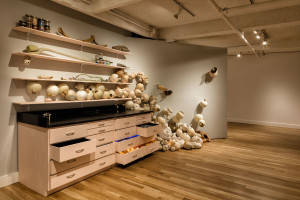
With this additional confidence, Russo’s work has continued to become bigger, lighter, more complex and more playful. The three new works that make up the majority of the final section, “Cavea-Culina,” “Lightness of Being (Settled),” and “Chute” take risks by challenging our notions of what ceramics ought to be by playing with space and incorporating unconventional media.
Noting that the average person looks at a piece of art for only a few seconds, Russo says she wanted to make pieces that would require the viewer to slow down and investigate them.
All three pieces incorporate everyday objects from Russo’s life, some of which are covered in clay and fired. They engage the audience and make use of space in ways ordinary sculptures do not.
“Cavea-Culina” is based around a large lab bench (previously used in Russo’s studio) with surreal, cell-like life-forms that emanate light from within. Viewers are also encouraged to open other drawers, revealing a number of miniature exhibits, each with its own style (light-based, organic, liquid, etc.).
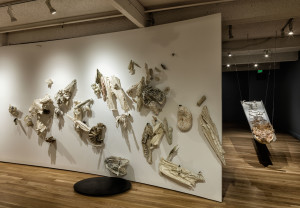
“Lightness of Being (Settled)” features a multitude of found objects converted into porcelain sculptures and spaced out along a long, curved wall. Russo resurrects the unnecessary clutter from her home, making the heavy weightless and the fleeting permanent.
“Chute” concludes the exhibition. It consists of many white, unglazed and broken ceramic pieces in the shapes of various bones and body parts sitting on a metal chute. Though they’re glued in place, the pieces appear to be sliding down the chute.
Asked about the meaning, Russo jokes, “I’m going down the chute, honey. I’m 54.”
Inspired by a recent shoulder injury, “Chute” is another comment on decay and the impermanence of life. Unlike her early work, which makes the same point, “Chute” does so with a sense of humor.
What really differentiates Russo’s recent work is that it not only accepts dissonance, it uses it. Her work allows us to feel complex things, or to laugh at death. Russo has the courage to present life as it is — contradictory and absurd — and to leave it at that.
“If you do enough stuff, no matter how tricky it is, you have this confidence,” Russo says. “You know it’s going to be fine.”
While coalescere showcases work from her 25 year career, Russo hesitates to call it a retrospective.
“In a lot of ways I feel like I’m just getting started.”
On the Bill: Martha Russo: coalescere. BMoCA, 1750 13th Street, Boulder, 303-443-2122. Through June 12.














